| Dept of Biology, Lewis and
Clark College |
|
Dr Kenneth Clifton |
| |
Biology
221 Lecture Outline |
|
Water!
Water's unique properties play an important
role in shaping life in the sea.
Seawater is a complex solution with
important properties as a solvent,
heat
sink, and absorber
of light.
Water is also unique because its density as a solid is
less that as a fluid (ice floats): Why is this important?
Water
motion in the form of
currents,
waves,
and tides
also plays important biological roles.
Water as a
solvent
Water's molecular polarity allows
binding with ions
Hydrophobic reactions also play important
biological roles (e.g. lipid membranes, protein folding,
etc.)
"Salinity" reflects a to the
concentration of a collection of many inorganic solids within
water.
The long residency of many
elements (Na, Cl, Sr, etc.) keeps them in relatively
constant ratio.
Major elements (0.1 - 20
ppt): Cl-; Na+;
SO4-2; Mg+2;
Ca+2; K+;
HCO3- (total = ~ 35 ppt or "parts per thousand")
Minor elements (0.1 - .001 ppt):
Br-; H2BO3- ;
Sr+2; F-
Trace elements (e.g., N, P, Fe) may
be biologically limiting
Salinity is influenced by evaporation
and dilution
In general, gasses become more soluble with pressure, so more dissolved gasses at deeper depths
However! Oxygen does not follow this rule: like many other gasses, it dissolves at the sea
surface. This, plus photosynthesis, minus
respiration, determines local O2 levels
This leads to an "oxygen minimum zone" around 1000 - 2000m.
Also, Oxygen dissolves more in cold
water, and less in salty water (i.e. lots of O2
at the poles)
Water as a heat
sink
It takes 1 calorie to raise 1 gram of
water 1 °C
Translation: Relative to air, it takes lots
of heat to change water's temperature
Water has a high heat of
vaporization
Translation: water absorbs
lots of heat before evaporating
Bottom line: Water's ability to
hold and transfer heat contributes directly to the world's
climate
Back to the
top
Water as an absorber of
light
Sunlight hits the earth from different
angles and is either reflected or absorbed
Absorption of different wavelengths occurs
at different rates
Infrared and ultraviolet attenuate
rapidly. Blue penetrates better than red
Light intensity diminishes exponentially
with depth
Important for photosynthesis and
for visual predators seeking prey
Limits on light penetration define the "photic" and "aphotic" zones of the oceans
Intense light levels in shallow water can
be bad
Diffusion within seawater allows
molecules (nutrients, gasses) to disperse
All else being equal, this should
promote uniformity
Various factors may counter the
effects of diffusion
Differences in water density
(pycnoclines) may inhibit mixing
Temperature plays a role,
as warmer, less dense water tends to rise.
Solar heat creates
thermoclines that vertically stratify water masses
Salinity also affects
density... a rapid shift in salinity is called a "halocline"
Cold, saline waters
sink
As mentioned earlier: Pressure increases with depth,
this changes the solubility of gasses
Back to the
top
Water
motion may also disrupt or override diffusion
Ways that water moves: currents,
tides, waves
Currents
are directional flows
Water movements directly
influence patterns of temperature and nutrient
availability
Winds and the Earth's west to east
rotation cause global currents
Coriolis effects
within fluids: particle deflection on a rotating
sphere
To the right in the north and to
the left in the south
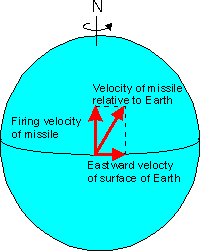
Westerlies and trade winds are driven by
atmospheric pressure differentials (remember those Hadley cells from Bio 141?)
Winds over water lead to deflections in currents due to "Ekman Spirals"
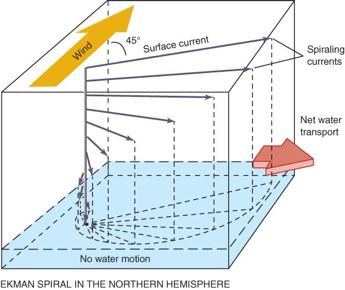
These winds, plus Coriolis effects, create
hemispheric gyres of water motion
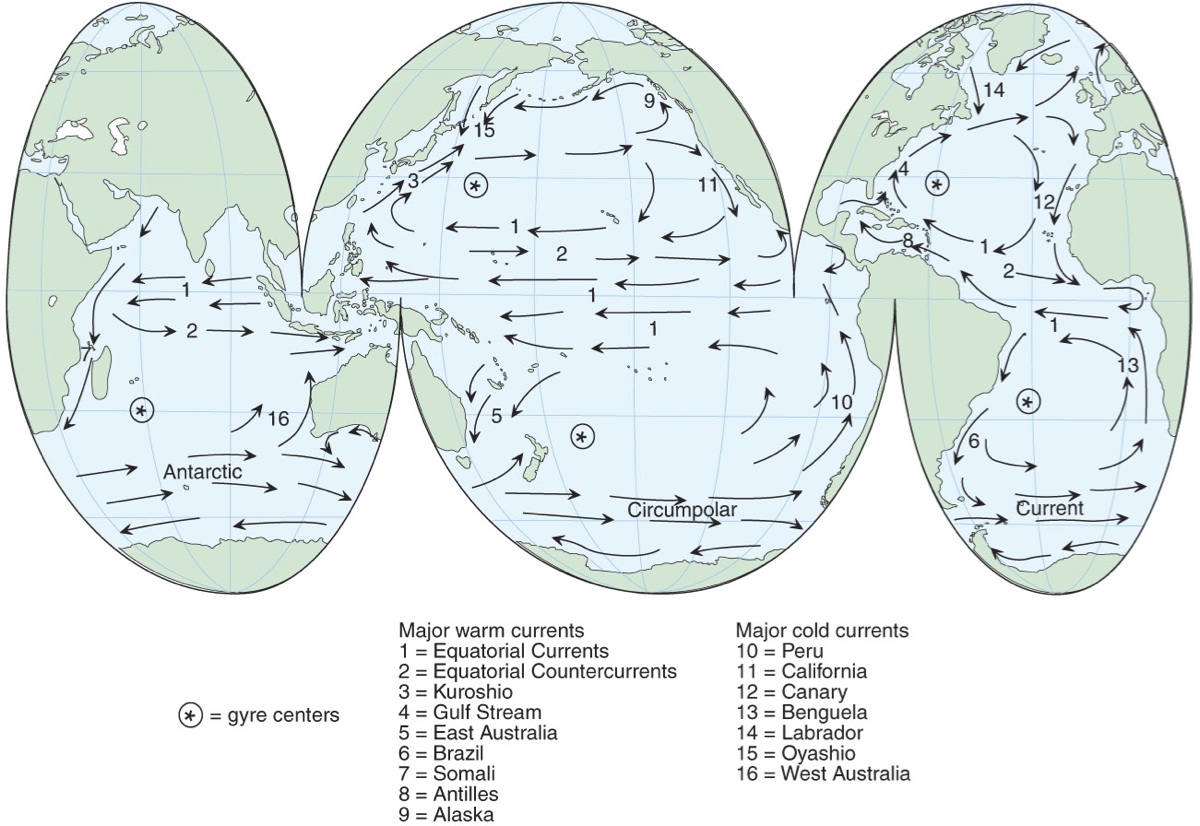
See section 2.1 in your text
The basic pattern: clockwise in the north,
counterclockwise in the south
Try the internet for additional explanations
of how coriolis effects influence water motion
Yet
another water page, including a bit of animation about coriolis
effects
Wind on water along western shores produces
upwelling of deeper water
This occurs because of "Ekman Spirals" see figure in text.
These cold, nutrient-rich waters
increase biological productivity
Counter currents may occur when water piles
up
Strong current reversals (El Nino
events) shut down upwelling
Large storms can also cause water to pile up
(storm surges)
Not all currents are obvious from
the surface
Deep water currents originate at
the poles.
They reflect differences in
temperature and salinity (hence the term: "thermo-haline circulation"
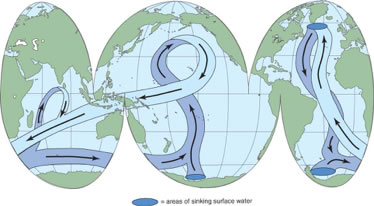
These currents deliver oxygen rich
waters to the depths and distribute waters of different temperatures to other parts of the planet.
Back to the
top
Waves:
wind driven "packets" of energy
Why are waves important?
Waves are a "predictable" source
of disturbance along coastlines
Wave energy determines grain
size of sediments (beaches, mudflats, etc)
Most waves originate from wind
Wave size/height (crest to trough)
depends on fetch, wind speed, and duration
Other important components of
wave energy
Wavelength (L)
Period (T)
Velocity (V)
These are related: V = L/T
Waves break after "feeling
bottom"
Shoreline topography
influences wave energy
Refraction may focus energy on
headlands
Rip currents sweep away from
shore
Longshore currents move down the
coast
Seasonal differences in wave energy
can shift local topography (berms and bars)
Tsunamis ("tidal waves"): seismic
waves have nothing to do with tides
High speed (600 km/hr) = lots of
energy!
Unpredictable catastrophic events on
some coasts causes intermittent temporal disturbance on a massive scale
You probably have seen video of the 2011 Japan tsunami... This
video gives a sense of how the tsunami in Indonesia came
ashore in 2004.
Back
to the top
Tides
generate locally predictable patterns of depth and current
Thus, tides influence many aspects of marine
biology. For example: The intertidal
Reproduction is also often linked
to the tides
What causes tides?
Gravity waves driven by
the motion of sun and moon
Relative celestial position influences
tides
Why is there a bulge of water opposite of the moon's gravitational pull?
Here are a couple good sites that talk about
tides and their predictions:
NOAA's Tides and Currents site
Tide
and current predictions
Neap tides and Spring
tides
Patterns of ebb and flood are also
influenced by local topography
Here is a map of different tide types around the planet
Here is what the mixed semi-diurnal tides near Bay Center, WA, look like this month:
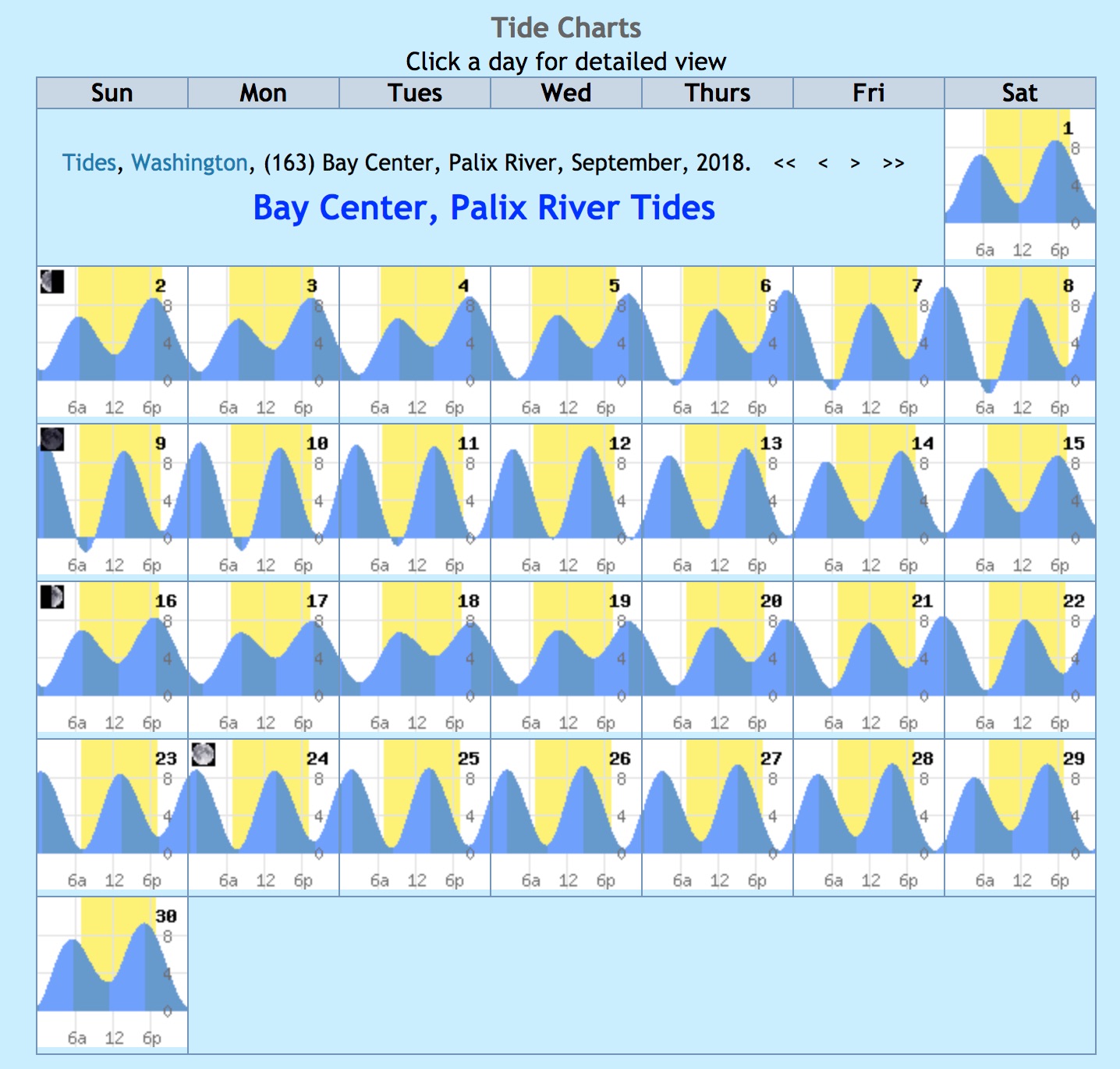
Conclusion: In combination, the various chemical and physical properties of
water create or organize many different ecological patterns
within the sea.
Back to the
top
Back
to the Marine Biology Moodle Page




